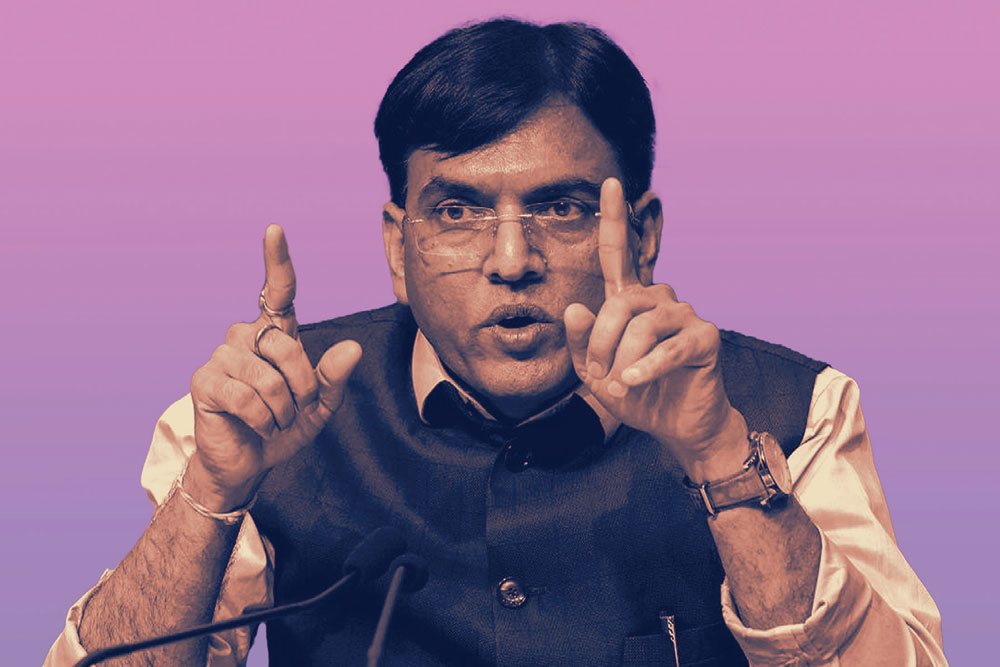Giving Credit Where It’s Due
How account aggregators will revolutionise FinTech in India
 Rajnish Kumar
Rajnish Kumar
 Rajnish Kumar
|
10 Sep, 2021
Rajnish Kumar
|
10 Sep, 2021
/wp-content/uploads/2021/09/Credit1.jpg)
(Illustration: Saurabh Singh)
BETWEEN 2011 AND 2017, the share of people in India with a bank account jumped from 30 per cent to nearly 80 per cent. In a report published in 2019 by the Bank of International Settlements, the authors claimed that what India achieved in seven years in financial inclusion would have taken any other country 47 years. In 2021, at 25.5 billion India had the highest number of real-time payments. Second-ranked China only had 15 billion, followed by South Korea’s 6 billion.
Over the last decade, India has invested in world-class digital financial infrastructure. The foundation was laid with the trinity of Jan Dhan Yojana, Aadhaar and mobile connectivity (also known as JAM). By providing every Indian a no-frills bank account, a unique identification number and a mobile phone every individual was given a digital existence. Once every individual was uniquely identifiable and linked to a bank account, the Government started Direct Benefits Transfer, enabling people to spend the money that is being deposited straight in their bank accounts. On top of JAM, more layers were added such as eKYC for identity verification and Unified Payments Interface (UPI) for real-time mobile payments. This came to be known as the India Stack, which has powered a fintech revolution in India.
On September 2nd, India took the next step in this journey. Eight banks joined the account aggregator network, taking 30 crore account holders a step closer to true control of their data. To understand what an account aggregator does, we need to understand the problem it is trying to solve.
Small businesses, or micro, small and medium enterprises (MSMEs), find it difficult to get credit from banks in India. The RBI MSME Committee report estimated that credit demand to the tune of Rs 25 lakh crore was going untapped in the MSME sector. Obtaining a loan requires time, patience and paperwork—the process became even more difficult during the coronavirus pandemic. Banks need to verify a borrower’s documents and trustworthiness before they can provide a loan. Currently, they rely on a mix of paperwork and intuition to do this and there is an overemphasis on issuing loans only when backed by ‘collateral security’—in other words, an asset a bank can seize in case of default—which many a time MSME borrowers are unable to offer. This means only those who already have assets can afford loan from a bank. Concern about default has increased post-pandemic, further reducing banks’ appetite to lend to stressed segments.
This catch-22 often forces poorer individuals and small businesses to turn to the informal sector. The informal moneylending market is usurious and uses unsavoury tactics to collect payment. However, it is able to deliver credit with speed, which the formal sector is still unable to match, to an underserved population. But it doesn’t have to be this way. The digitalisation of the economy and cash flow, and machine learning-based models can change the situation completely. Let’s see how.
Since the systems that power our financial infrastructure are digital, every transaction leaves a data trail. This data trail is currently available only to the party you transact with. For example, all the data related to income and expenses from your bank account are only with your bank. Similarly, the record of expenses on your credit card remains only with your credit card company. If you invest your money, the record of your portfolio is only with your broker or exchange.
Every individual’s life is different; so are their finances. Every individual therefore needs tailor-made products to make better financial decisions. To be able to truly help people make sound financial choices, one needs to take into account the financial decisions they have taken in the past.
Tailor-made financial products need these disparate data to devise better options for each customer. Moreover, if these data can be shared in a secure manner, even the pace of financial services such as bank loans can be accelerated. Banks will see a reduction in the cost of due diligence and underwriting.
Account aggregators standardise the format for requesting financial data and the conditions for consent on that data. Once you have the ability to aggregate financial data from all institutions, the possibilities become endless. Imagine an AI-based personal finances manager that sets aside your savings automatically based on its expectations of your spending learnt from analysing your data across credit cards and bank accounts. AAs can unlock a revolution in financial services
Some may even be willing to issue a loan virtually, without meeting the borrower in person or demanding any paperwork. Today, with machine learning, artificial intelligence (AI) and other supporting technologies, this is not a pipe dream—the only hurdle is our inability to pool disparate data.
Account aggregators (AAs) are the mechanism to share these data securely.
Let’s take a hypothetical example. Rajesh is a small trader who has never taken a formal loan for his business, although he did get some financing for a scooter he bought two years ago from Bajaj Finance. Since the Goods and Services Tax (GST) was implemented, Rajesh has been raising invoices and filing them in the GST Network for the last two years. He has a personal account with ICICI and a business current account with Union Bank.
If Rajesh asked a bank for a loan for his business, the bank would ask him to present financial records pertaining to his business as well as his personal assets. He would need statements from Union Bank and ICICI bank, his tax returns, and audited balance sheets from his company’s accountant. After putting together this paperwork, Rajesh would still need to visit the bank branch and meet the manager who would confirm that the documents were genuine and Rajesh was indeed who he claimed to be.
With AAs this long process can be replaced with an instant loan. An AA is a consent manager for data sharing. This means that it only collects from the user their willingness to share their data from one financial institution with another. The AA itself is not privy to any of the user data. Moreover, AAs are regulated. They are fiduciaries to the user and must therefore put Rajesh’s interests above everything else.
So if Rajesh were to approach State Bank of India (SBI) for a loan, instead of visiting three other institutions to get his data, he would only have to give his consent for data sharing to his preferred AA. The AA will then verify Rajesh’s identity and on confirmation send his consent to all the service providers who have his data such as Bajaj Finance, ICICI and the GSTN portal. SBI receives these data directly from these institutions after encryption, along with Rajesh’s consent embedded in an artefact. This consent will also specify what data can be used, for how long and for what purpose. The receiving institution, in this case SBI, must conform to the conditions laid down in the consent artefact.
THANKS TO THE AA, SBI is now sure that the data they have received are accurate and trustworthy. It unlocks data for the lending process that was hitherto unavailable to the bank.
Further, with cloud computing and machine learning-based underwriting models, a lot of the decision making is moving from the bank manager to computers. This shift can reduce the costs of issuing and serving a loan drastically, while also increasing the bank’s capacity to issue loans. All of this will allow a massive change in the lending industry. Instead of high-value, asset-backed lending such as home loans and car loans, banks can now do low-value, information-backed lending such as a working-capital loan to small traders such as Rajesh based on their digital footprint as well as have control over the cash flow ensuring timely servicing of the loan.
To be able to truly help people make sound financial choices, one needs to take into account the financial decisions they have taken in the past. Tailor-made financial products need these data to devise better options for each customer. AAs are the mechanism to share these data securely
AAs as a data utility are essential to the future of the country’s financial sector. So far, keeping financial data with only the institution that generated it was considered best practice, to preserve user privacy and data security. However, the opportunity cost of this siloed approach is all the innovative products that could have been built if data were made available for use as deemed fit by the owner. This lack of innovation is keeping hundreds of thousands from obtaining formal credit and improving their lives.
AAs enable siloed data to be shared using an open protocol approach. Open protocols themselves have been tremendously successful in creating vibrant, competitive ecosystems of innovation. The biggest example of this probably is the internet. The internet protocol, or IP, is an open standard that allows billions of devices to be on the same network and exchange information with each other freely. Closer to home, India built the open payments protocol called UPI.
Before UPI, if you had to make a digital payment from your HDFC bank account, you had to use either HDFC’s mobile banking app or website. However, today with UPI, the apps that let you pay have been unbundled from where you bank. You can theoretically send money from your SBI bank account to any merchant using an app made by PhonePe. This is possible because UPI standardises the communication protocol between banks. Which means an instruction saying “Send Rs 1,000 to receiver@bank”, generated by any UPI frontend app, is interpreted reliably and in the same way by all participating banks in the UPI backend network.
AAs do something similar for your data. They standardise the format for requesting data and the conditions for consent on that data. Each financial institution is then ready to respond to that request by sharing user data in a trustable and encrypted manner. Credit is only one-use case. Once you have the ability to aggregate financial data from all institutions, the possibilities become endless. Imagine an AI-based personal finances manager that sets aside your savings automatically based on its expectations of your spending learnt from analysing your data across credit cards and bank accounts. Or a portfolio manager that handles investment risk and balances your portfolio at a system level, no matter how many brokers, exchanges or institutions you use to manage your wealth.
The pandemic has disrupted all our lives. Social distancing and lockdowns have affected all our routines, but the shock was much harsher for some. For many individuals and small businesses, lockdowns hit their finances. Incomes have dried up. Expenses, especially medical ones, have destabilised many families. To reconstruct their lives, businesses need capital to make it through the tough times. In such a situation, the capability to raise loan seamlessly is a godsend.
AAs can unlock a revolution not just in credit but in financial services more broadly. I am excited that, as usual, India is leading this change from the front.

/wp-content/uploads/2025/06/Cover-OpenMinds2025.jpg)












More Columns
'Gaza: Doctors Under Attack' lifts the veil on crimes against humanity Ullekh NP
Armed with ILO data, India will seek inclusion of social security in FTAs Rajeev Deshpande
Elon Musk Returns to Rebellion Mode Against Trump Open